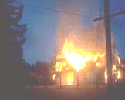Reading-based Thales Research and Technology (TRT) UK have unveiled three new technologies which could help emergency services save lives.
A GPS system that works inside buildings could help firefighters find their way through smoke-filled rooms and allow for more organised searches. The technology is being developed alongside two tools for managing crises.
The GPS system will be integrated into the firefighters uniforms to allow a control centre to track their progress and positions within a building during a call out. This means any firefighters who get into trouble could be identified earlier and commanders can immediately see which parts of the building have not been searched.
UltraWideBand (UWB) radio is used to position the GPS units relative to each other and units outside the area, which are located using traditional GPS. This means the position of the unit can be calculated to within a metre.
‘Hampshire fire service told us that if it can’t be used in small operations, they wont use it in large ones.’ said David Harmer, chief engineer at TRT. ‘So we had to come up with a system which be used for all call outs.’
The units send signals to each other and external units so the distances between them can be measured and their position be triangulated. There must be four external units to give an accurate position of the people inside, but two transmitters could be fixed to an appliance meaning only two appliances (the minimum number sent to calls) would be needed for the system to work.
UWB is used to reduce the effect of confusion with signals reflected from a building’s walls. An original signals wide bandwidth can be separated from the narrower signal reflected from walls, giving an accurate distance from another unit.
The information is then presented in 2D and 3D to the control centre to give a sense of where the people are as well as the detail of surroundings. This can then be used to ensure the whole of a building is searched and help firefighters who become disorientated by smoke. The system also plans to incorporate dropped units which can act as beacons, for example to mark casualties, and also improve the effectiveness of the system by helping the signal penetrate further into the building.
The final unit is anticipated to be the size of a credit card so firefighters could wear them attached to their uniform, on their shoulders or even possibly in their helmets.
In addition to this TRT also demonstrated two tools aimed at improving crisis management. The nuVa desk (pictured below) is part of their Virtual Collaboration Solutions (VCS) to allow people to work together in real time, regardless of distance, and their OBSCURE technology can be used to keep information secure across the multiple levels of access needed to effectively deal with a crisis.
The nuVa desk uses a smart/intelligent white board and projected computer screen to allow the user to become ‘surrounded’ by their work. Documents and applications can be moved around like pieces of paper and drawn on using a pen. These desks are connected together over the internet using an encrypted link and above the desk is a screen showing the other connected people. You can talk to them as you work and their desk shows the same work and markings that you make. This is designed to allow people to work together as easily as if they were in the same room.
‘The desk is being tested by Thales e-Security in their offices in Brighton, Reading and Oslo,’ said Andy Vooght, head of VCS. ‘It has allowed the Brighton office to save £60,000 on travel in less than a year.’

OBSCURE technology allows information to be compartmentalised in secure packages with different users allowed access to specified packages. This allows all the information to be kept in one system, but more sensitive information is kept secure.
For crisis management, this allows top commanders to have access to all information, with people lower down the chain being given information according to their need, until finally the basic information is available to the public.
One example of how this technology could help is in large floods where potential further flooding, positioning of units and weather information could all be added in real time to help give the full picture. Information regarding evacuations and road blocks could be made available to the public, while placing of emergency units and flood defences could be kept secure and only available to certain officials.
TRT’s ultimate aim would be to combine all these technologies to provide an ultimate crisis management tool.




Poll: Should the UK’s railways be renationalised?
I think that a network inclusive of the vehicles on it would make sense. However it remains to be seen if there is any plan for it to be for the...